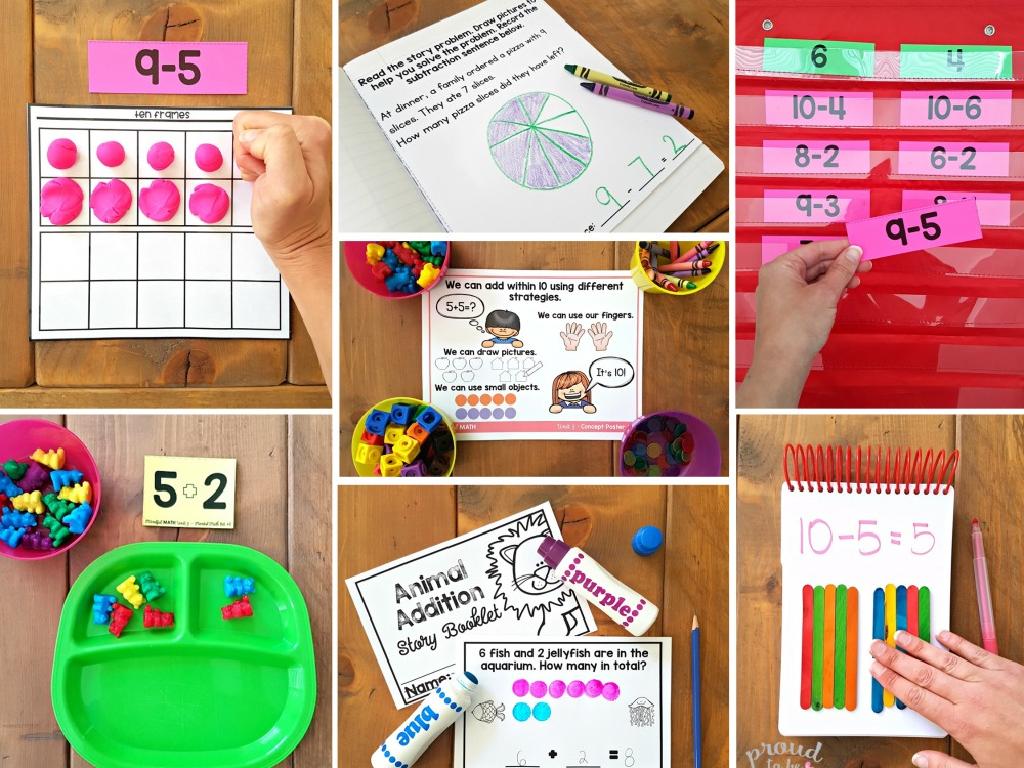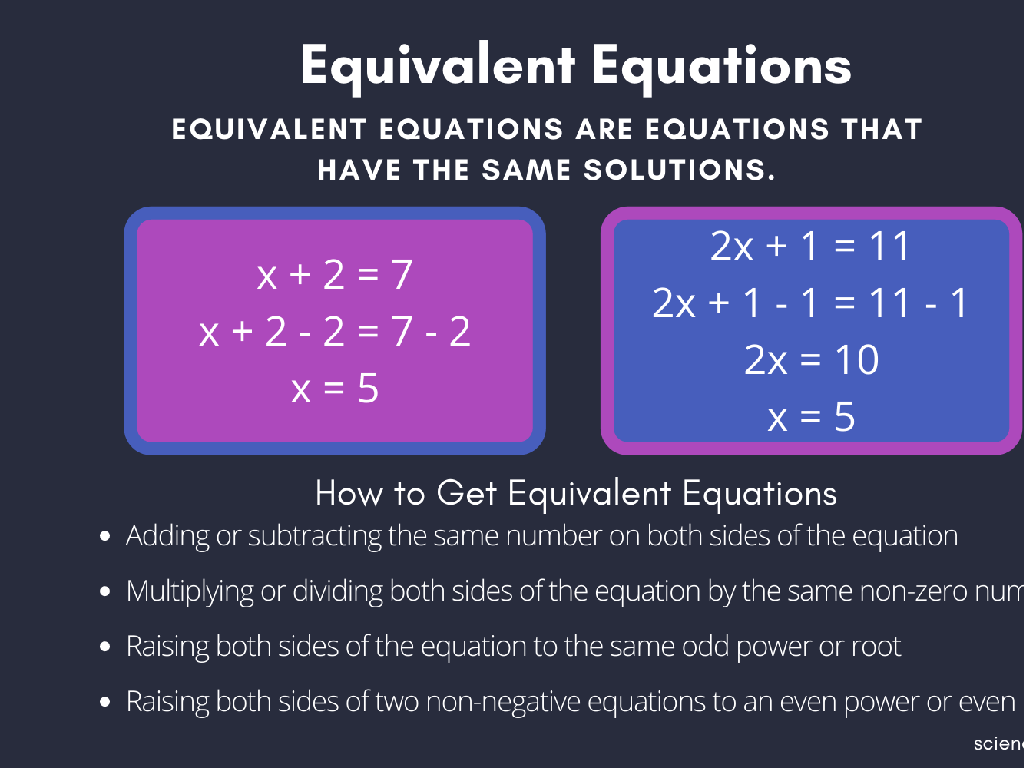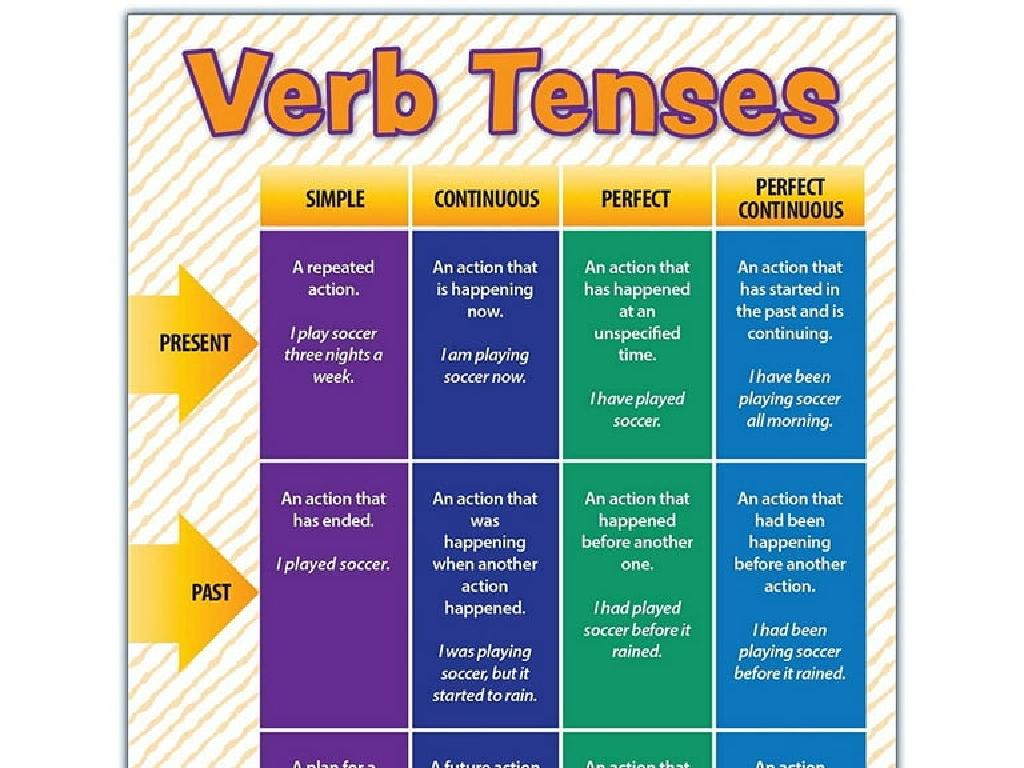Convert Fractions To Decimals
Subject: Math
Grade: Fifth grade
Topic: Convert Between Decimals And Fractions
Please LOG IN to download the presentation. Access is available to registered users only.
View More Content
Understanding Fractions and Decimals
– What are fractions?
– Fractions represent parts of a whole, like 1/2 of a pizza.
– What are decimals?
– Decimals are another way to show parts of a whole, like 0.5 of a dollar.
– Fractions vs. Decimals
– Fractions and decimals in real life
– Use fractions for slices of cake (1/4) and decimals for money ($0.25).
|
This slide introduces the concept of fractions and decimals to fifth graders, highlighting that both are different methods to represent numbers, particularly parts of a whole. Begin by explaining fractions as divisions of a whole into equal parts, using relatable examples such as slices of pizza or cake. Then, introduce decimals as another representation, akin to coins in a dollar. Emphasize that while fractions and decimals look different, they can express the same value and are interchangeable. Provide real-life scenarios where both fractions and decimals are used, such as in measuring ingredients for a recipe or calculating money. Encourage students to think of their own examples where they encounter fractions and decimals in their daily lives.
Understanding Fractions
– Definition of a fraction
– A fraction represents a part of a whole
– Numerator and denominator
– Top number is numerator, bottom is denominator
– Fractions in daily life
– Pizza slices, money, and measuring cups
– Converting to decimals
|
Begin the lesson by defining a fraction as a part of a whole, which is divided into equal parts. Explain that the numerator (top number) indicates how many parts we have, while the denominator (bottom number) shows the total number of equal parts the whole is divided into. Provide relatable examples such as slices of pizza to represent fractions (e.g., 1/2 of a pizza means 2 slices out of 4 total), coins to represent money (e.g., 1/4 of a dollar is 25 cents), and measuring cups in cooking (e.g., 1/3 cup of sugar). After discussing fractions, introduce the concept of converting fractions to decimals, which will be explored in the following slides. This foundational understanding is crucial for students to grasp more complex concepts involving fractions and decimals.
Understanding Decimals
– Definition of a decimal
– A decimal is a number with a point that separates the whole part from the fractional part.
– Decimal place values
– Each place after the decimal represents a fraction with a denominator of a power of ten.
– Decimals in daily life
– Money is a common example: $1.25 means 1 dollar and 25 cents.
– Converting fractions to decimals
|
This slide introduces the concept of decimals to fifth graders. Begin with the definition, emphasizing that decimals are another way to represent fractions. Explain place value by comparing it to whole numbers, but instead of tens, hundreds, and so on, we have tenths, hundredths, etc. Use relatable examples like money to illustrate decimals in a context familiar to students. Finally, touch on the process of converting fractions to decimals, setting the stage for more detailed exploration in subsequent slides. Encourage students to think of other examples where they encounter decimals in their daily lives.
Converting Fractions to Decimals
– Use division to convert fractions
– Divide the numerator by the denominator
– Convert using equivalent fractions
– Use fractions equal to tenths or hundredths
– Practice with common denominators
– Easier conversion with denominators of 10, 100
– Understand decimal equivalents
– Recognize fractions like 1/2 is 0.5, 3/4 is 0.75
|
This slide introduces students to the concept of converting fractions to decimals. Start by explaining that fractions can be converted to decimals by dividing the numerator (top number) by the denominator (bottom number). Show how knowing equivalent fractions can simplify this process, especially when dealing with fractions that have denominators of 10 or 100, which are easily converted to decimals. Provide examples and practice problems to help students become familiar with common conversions, such as 1/2 to 0.5 or 3/4 to 0.75. Encourage students to memorize some basic conversions and to use division for more complex fractions. This foundational skill will be useful in future math concepts.
Converting Complex Fractions to Decimals
– Steps for conversion to decimals
– Divide the numerator by the denominator
– Use long division for fractions
– Place the decimal point in the quotient
– Example: Convert 3/8 to decimal
– 3 divided by 8 equals 0.375
|
When converting complex fractions to decimals, the key is to divide the top number (numerator) by the bottom number (denominator). Start by writing the fraction as a division problem. For example, 3/8 means 3 divided by 8. Teach students how to set up long division and where to place the decimal in their answer. Use 3/8 as a clear example, showing step-by-step how 3 divided by 8 equals 0.375. Make sure to explain that the decimal result is another way of representing the fraction. Practice with more examples to ensure understanding.
Practice Time: Fractions to Decimals
– Convert fractions to decimals
– Class example walkthrough
– We’ll do some examples as a class to learn the process
– Individual practice with support
– Try converting on your own and ask for help if needed
– Share and discuss answers
– We’ll review answers together to understand different methods
|
This slide is designed for an interactive class activity focused on converting fractions to decimals. Begin by explaining the process of conversion, possibly by dividing the numerator by the denominator or by using equivalent fractions that are easy to convert. Then, work through a few examples as a class, ensuring that students understand each step. Afterward, give students a set of fractions to convert on their own, providing help as needed. Encourage them to use scratch paper to work out the problems. Finally, come back together as a class to share answers, discuss different methods used, and clarify any misunderstandings. This activity will help solidify the concept and give students confidence in their ability to convert fractions to decimals.
Class Activity: Decimal Detective
– Pair up for fraction conversion
– Convert list of fractions to decimals
– Use division to turn fractions into decimals
– Check answers with another pair
– Ensure both pairs agree on the answers
– Discuss findings with the class
– Share methods and any challenges faced
|
In this engaging class activity, students will work in pairs to apply their knowledge of converting fractions to decimals. Provide each pair with a list of fractions to convert. Encourage them to use long division if necessary and remind them of the relationship between the numerator and denominator. After conversion, pairs will team up with another pair to compare answers, fostering collaboration and peer learning. Conclude the activity with a class discussion, allowing students to share their strategies and any difficulties they encountered. This will help reinforce their understanding and provide an opportunity for you to address common misconceptions.
Wrapping Up: Fractions to Decimals
– Recap: Converting fractions
– Why both forms matter
– Knowing both helps in different math problems
– Homework: Conversion worksheet
– Worksheet with 10 problems to solve at home
– Practice makes perfect
|
As we conclude today’s lesson, it’s important to review the steps we’ve learned for converting fractions to decimals. Understanding how to represent numbers in both forms is crucial as it allows students to tackle a variety of mathematical problems with ease. For homework, students are provided with a worksheet containing 10 fractions that they need to convert into decimals. This practice will help reinforce the concepts learned in class and build their confidence. Encourage students to try solving the problems without a calculator first to strengthen their mental math skills. In the next class, we’ll review the homework answers and address any difficulties the students encountered.






